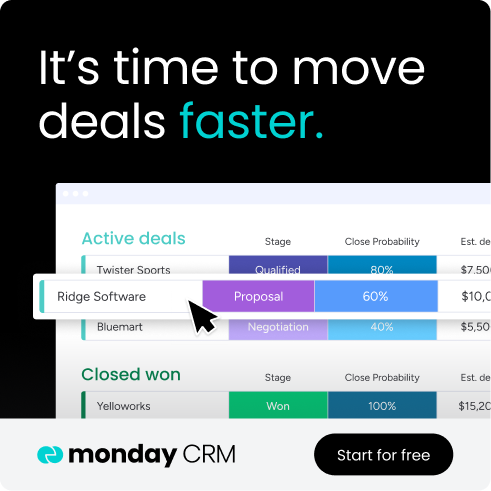A strong sales strategy depends on more than closing deals; it relies on accurate sales forecasts that keep promises aligned with delivery. When projections and inventory fall out of sync, even the most promising opportunities can stall, leading to missed revenue and lost customer trust.
Modern demand planning software bridges that gap by connecting real-time sales data with supply chain visibility. These platforms turn forecasting into a strategic advantage, helping teams anticipate demand, manage resources efficiently, and make smarter decisions faster.
This guide explores how effective demand planning can strengthen sales performance, improve predictability, and drive long-term growth. It also highlights the top AI-powered tools of 2025 that are transforming how teams plan, collaborate, and deliver results.
Key takeaways
- Demand planning turns forecasting into strategy: modern platforms transform sales forecasts from reactive estimates into proactive insights that align sales, operations, and supply chain teams.
- AI drives smarter forecasting: advanced machine learning models detect patterns and predict shifts in customer demand, helping businesses make faster, data-backed decisions.
- Collaboration improves accuracy: the best tools unite sales, marketing, and operations teams around shared data, replacing siloed reporting with one reliable source of truth.
- Integration is essential for visibility: connecting demand planning with core business systems such as CRM and ERP platforms ensures real-time visibility across the entire revenue cycle.
- monday CRM unites forecasting and sales execution: by embedding demand planning directly into sales workflows, monday CRM gives teams real-time insights, sharper forecasts, and greater confidence to deliver on every deal.
What is demand planning software?
Demand planning software provides your team with the critical foresight to anticipate customer purchasing behavior. It synthesizes historical sales data, market fluctuations, and other key signals to forecast future demand with remarkable precision. This capability allows you to sell confidently from existing stock and eliminate the frustrating ‘backordered’ conversation from your sales process.
The true power of this technology is unlocked when it unifies disparate teams, transforming individual guesswork into a cohesive, data-driven strategy. Imagine sales contributing frontline observations, marketing layering in campaign insights, and operations synchronizing production schedules — all within a single framework. The goal is to dismantle information silos and establish a reliable forecast that the entire organization can trust and execute against.
Integrating your essential tools with monday CRM amplifies this advantage significantly. By channelling real-time sales pipeline data and customer interactions directly into your forecasting models, your predictions gain an unparalleled level of sharpness. Your sales team transitions from a reactive posture to one that actively shapes demand, ensuring the right products are available for the deals you are strategically positioned to close.
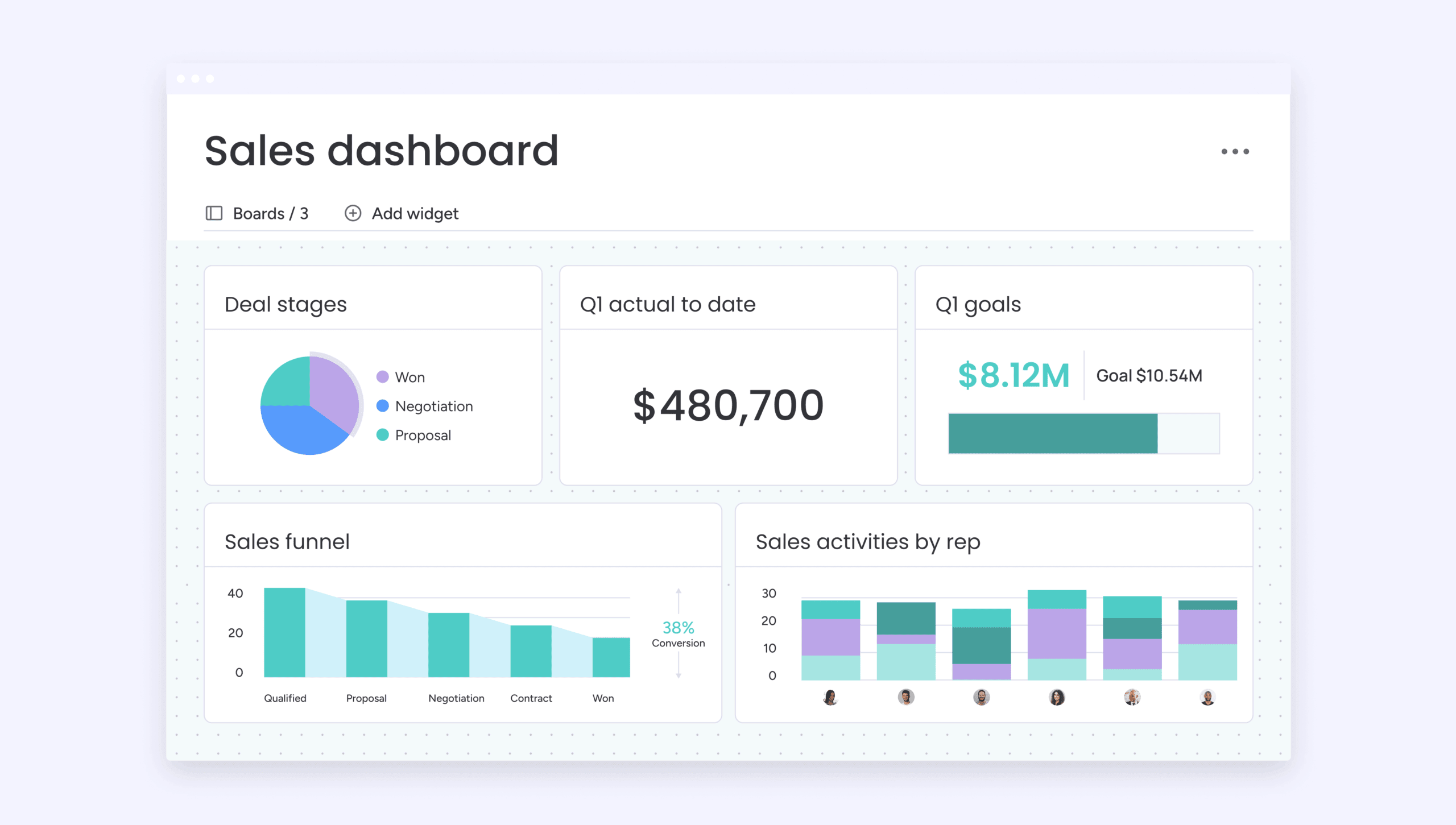
Top benefits of demand and supply planning tools
Unexpected stockouts can derail even the most promising deals. Effective demand and supply planning turns this risk into a strategic advantage, aligning sales forecasts with real-time inventory visibility to keep every promise deliverable and every customer confident.
When forecasting is connected across departments, teams move from reactive problem-solving to proactive coordination. A unified operational playbook replaces disconnected spreadsheets, ensuring that sales, marketing, and operations work from the same source of truth. This level of coordination strengthens every stage of the sales cycles, helping teams deliver on commitments with speed and precision.
Key benefits include:
- Stronger forecast accuracy: live data connects demand signals with supply capabilities, allowing teams to plan with confidence and avoid costly misalignment.
- Improved collaboration: shared visibility brings sales, operations, and finance together around consistent data, eliminating silos that slow down decisions.
- Optimized inventory management: teams can anticipate shifts in demand and adjust production or stock levels before issues arise.
- Greater customer satisfaction: when promises match delivery, customer trust grows, turning reliable execution into a lasting competitive edge.
By connecting forecasting with execution, organizations move from chasing data to driving performance — transforming demand planning into a true growth engine.
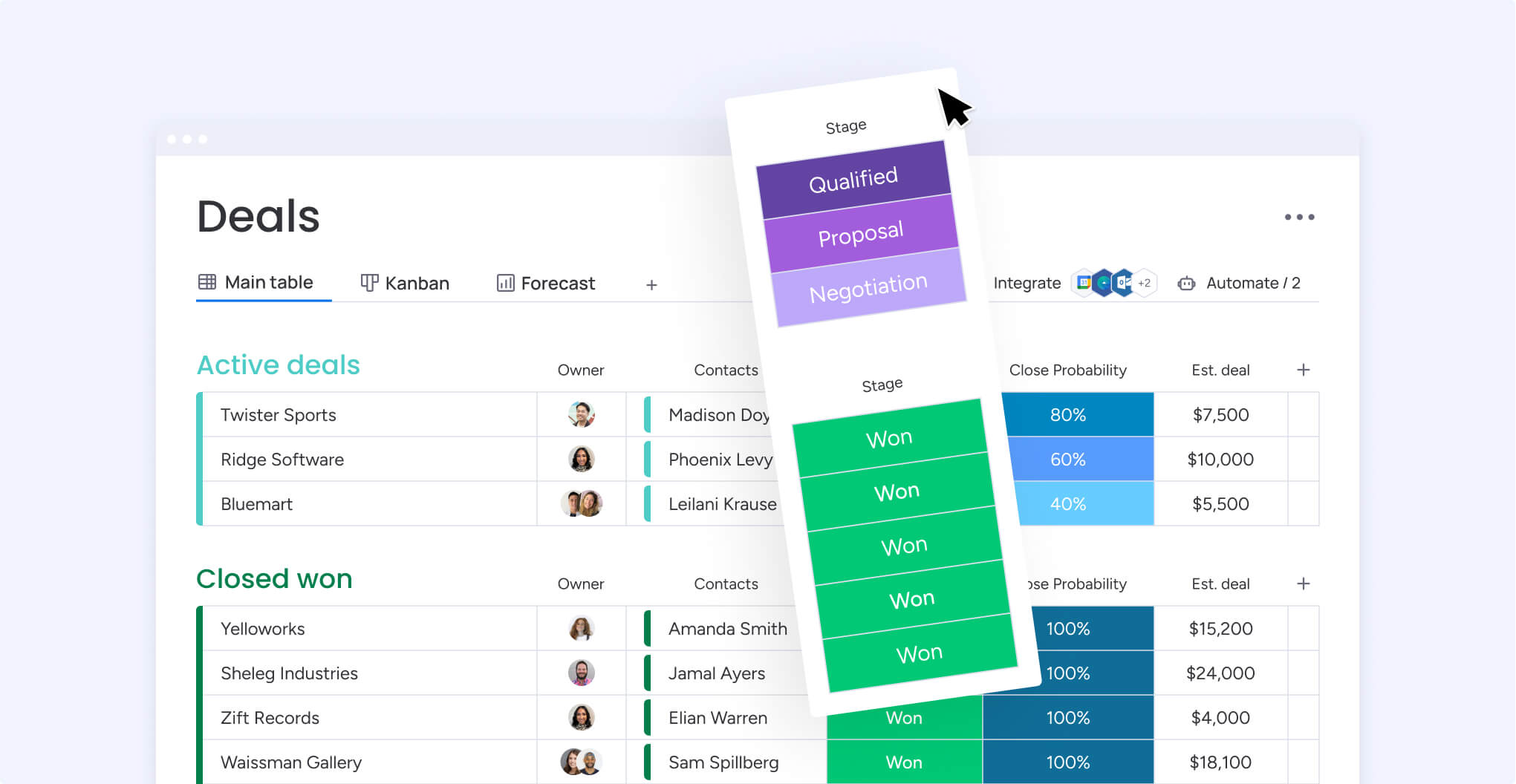
How to spot a sales CRM that sets your team up to win
Selecting a sales CRM is a strategic decision that shapes how efficiently your team operates and how effectively it grows. The right platform should fit naturally into your existing sales process, removing barriers, enhancing collaboration, and helping every representative move deals forward with confidence.
When assessing potential solutions, focus on platforms that offer:
- Flexibility to fit your team’s approach: a CRM should adapt to your established sales methodologies so your team can keep working in the way that delivers results best.
- Automation that drives productivity: built-in tools for AI sales automation should remove repetitive work like data entry and follow-ups, giving teams more time to focus on customers.
- Smooth integrations across systems: seamless connections with marketing, finance, and operations tools ensure everyone works from the same accurate data.
- Forecasting and insights that inspire confidence: real-time visibility into pipelines helps leaders and teams make informed, proactive decisions.
- An intuitive, user-friendly experience: simple navigation and clear workflows encourage adoption, turning the CRM into a genuine driver of sales momentum.
A well-designed CRM becomes more than a management tool: it acts as the foundation of a connected, high-performing sales organization built to grow with clarity and consistency.
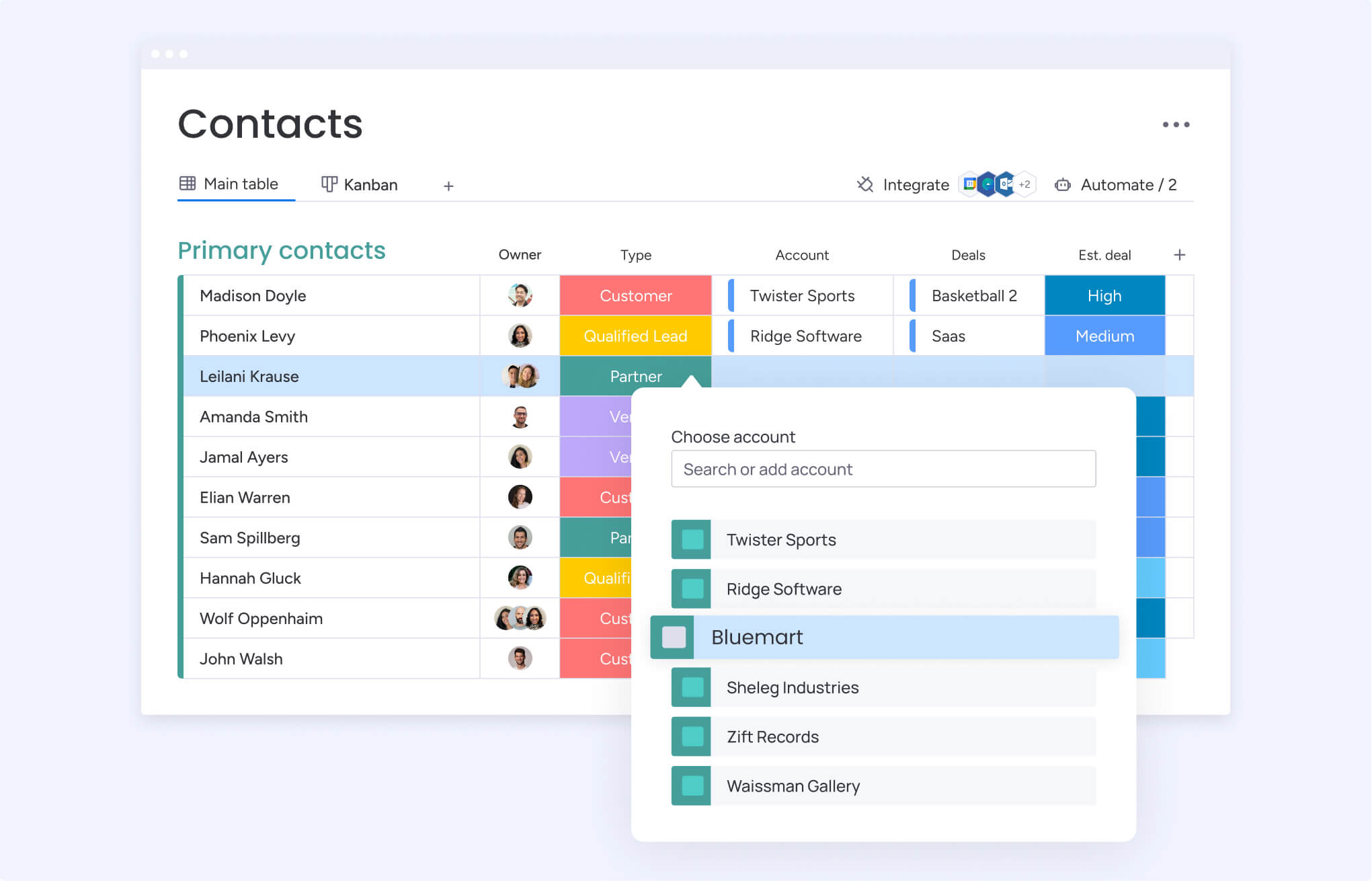
10 best demand planning platforms for 2025
High-performing sales teams do not just respond to changes in the market — they see them coming. Demand planning has become the foundation for staying ahead, transforming uncertain forecasts into clear, actionable insights that guide every decision.
The strongest platforms bring the entire revenue organization together around one reliable source of data. When sales, operations, and leadership work from the same information, teams can plan with accuracy, allocate resources effectively, and act with confidence.
The following platforms represent the leading solutions in 2025, each built to enhance forecasting precision, improve collaboration, and turn planning into a true competitive advantage.
1. monday CRM
monday CRM transforms demand planning from reactive guesswork into proactive strategy with its comprehensive revenue platform that extends far beyond traditional CRM boundaries. The platform combines intuitive visual workflows with AI-powered forecasting capabilities, making it perfect for sales teams who need to align demand predictions with revenue goals while maintaining complete visibility across their pipeline.

Example: monday CRM centralizes demand planning workflows with real-time visibility and AI-driven insights, enabling sales teams to forecast customer requirements and align resources proactively.
Key features:
- AI-powered sales forecasting with predictive analytics for demand patterns and seasonal fluctuations.
- Customizable dashboards that visualize demand planning metrics, inventory levels, and team performance in real time.
- No-code workflow builder with drag-and-drop functionality to create tailored demand planning processes.
Pricing:
- Free: $0 forever (up to 2 seats, 3 boards, basic templates).
- Basic: $9/seat/month billed annually (unlimited viewers, 5 GB storage, priority support).
- Standard: $12/seat/month billed annually (timeline views, automations, integrations up to 250 actions/month).
- Pro: $19/seat/month billed annually (private boards, time tracking, 25 K actions/month for automations).
- Enterprise: Custom pricing (portfolio management, enterprise-scale automations up to 250 K actions/month).
- Annual billing saves 18% compared to monthly plans.
- Minimum three users required for paid plans.
Why it stands out:
- Flexible Work OS approach allows teams to build custom demand planning workflows instead of being locked into rigid, predefined processes.
- Seamless integration between CRM data and demand forecasting creates a unified view of sales pipeline and resource planning.
- Visual, intuitive interface reduces onboarding time and increases team adoption compared to traditional enterprise demand planning software.
Advanced AI features
- Predictive demand forecasting: AI analyzes historical sales data and market patterns to suggest optimal reorder points and predict seasonal demand fluctuations.
- Smart inventory insights: machine learning identifies potential stockout risks and recommends proactive adjustments to inventory levels based on sales velocity.
- Automated pipeline analysis: AI-powered reports provide advance notice of customer needs by analyzing deal progression and close probabilities.
Automations
- No-code automation builder: create custom workflows that trigger actions like reorder notifications when inventory drops below thresholds or send alerts for forecast deviations.
- Pre-built demand planning recipes: ready-made automation templates for common scenarios like supplier notifications, inventory updates, and performance reporting.
- Enterprise-scale processing: handle up to 250 K automation actions per month on Enterprise plans, supporting complex demand planning workflows across large organizations.
Integrations
- API-first architecture: connect with existing ERP, inventory management, and supply chain systems through robust APIs and pre-built connectors.
- Popular enterprise tool connections: seamless integration with platforms like Salesforce, HubSpot, and major accounting software for unified data flow.
- Real-time data synchronization: bi-directional sync ensures demand planning decisions are based on the most current information across all connected systems.
Demand planning software features:
- Collaborative forecasting workflows: break down silos between sales, marketing, and operations teams with shared boards that track demand signals and resource allocation.
- Multi-view data visualization: switch between Kanban boards, Gantt charts, and custom dashboards to analyze demand patterns from different perspectives and identify bottlenecks quickly.
2. Anaplan
Anaplan delivers enterprise-scale connected planning that unifies demand forecasting with financial and operational planning across your entire organization. The platform specializes in AI-powered scenario modelling and real-time collaboration, making it ideal for large enterprises with complex, multi-departmental planning needs. Its patented Hyperblock® technology enables rapid calculations across massive datasets, turning planning from a reactive process into a strategic advantage.
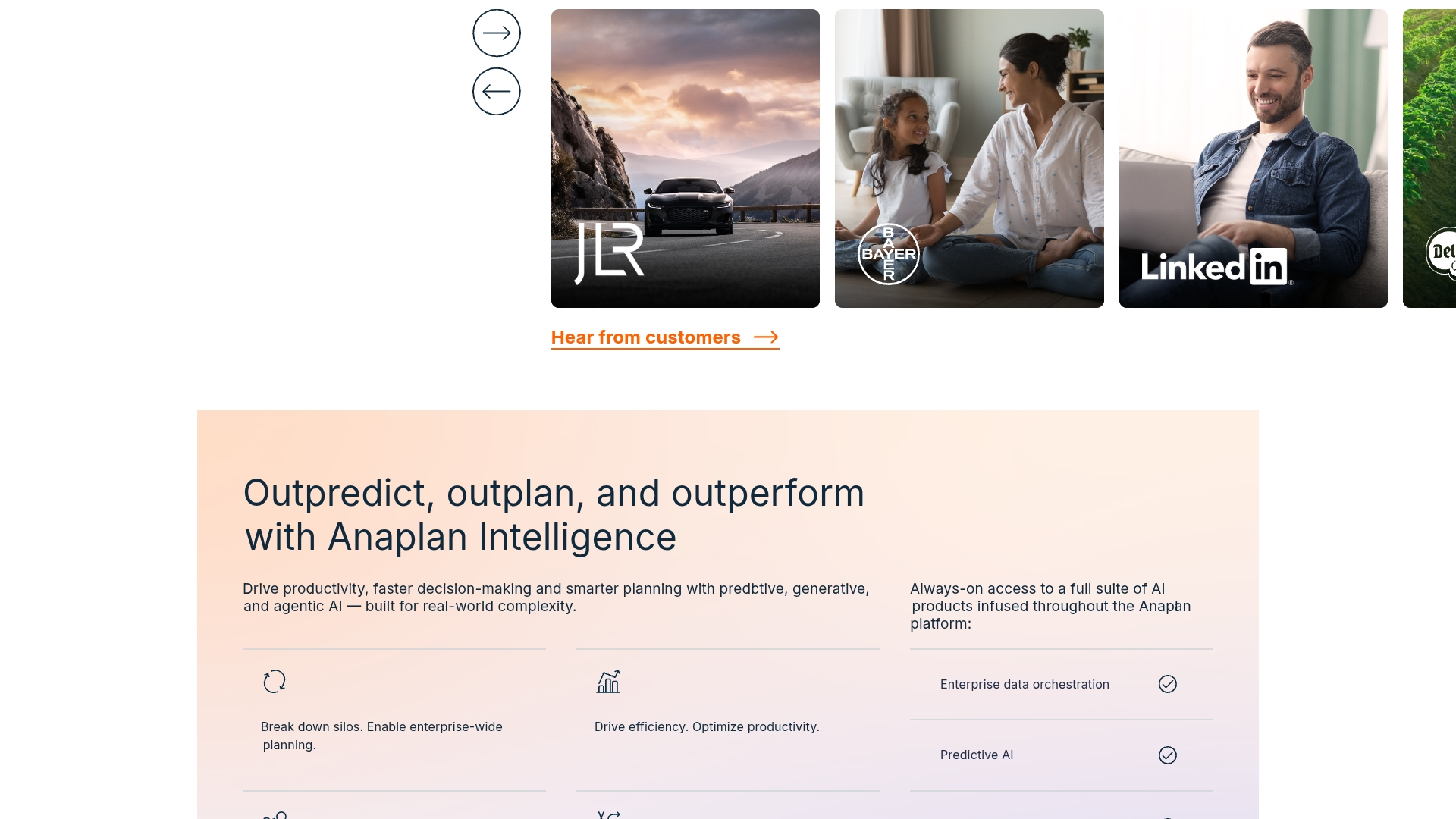
Use case: Anaplan transforms demand planning from siloed forecasting into connected planning that integrates seamlessly with financial budgets, supply chain operations, and strategic initiatives.
Key features:
- AI-powered demand sensing with real-time monitoring of demand signals and automated anomaly detection.
- Advanced scenario planning with “what-if” analysis capabilities across 27 statistical forecasting models.
- Cross-functional collaboration tools that enable sales teams, customers, and partners to contribute directly to demand forecasts.
Pricing: Pricing information is not publicly available and requires contacting sales for custom enterprise quotes.
Considerations:
- Steep learning curve for complex modelling requires significant training investment and technical expertise.
- High cost of ownership may not provide adequate ROI for smaller organizations without enterprise-scale complexity.
3. o9 solutions
o9 solutions transforms demand planning with its AI-powered “Digital Brain” platform that turns complex supply chain data into actionable insights. The platform specializes in integrated business planning and scenario modelling, making it ideal for Fortune 500 enterprises managing global supply chains across multiple markets.

Use case: o9 solutions delivers AI-driven demand planning that unifies collaborative forecasting, advanced analytics, and cross-functional scenario planning to help large enterprises achieve touchless planning and improve forecast accuracy by up to 51%.
Key features:
- Enterprise Knowledge Graph technology that creates a digital twin of your business for transparent, unified visibility across all planning functions.
- AI/ML-driven forecasting engines that process internal and external demand indicators to generate granular forecasts at daily or store-level precision.
- Exception-based forecasting framework with automated alerts that enables proactive, touchless demand planning and tracks forecast accuracy in real time.
Pricing: pricing information is not publicly available and requires contacting o9 solutions directly for a custom quote based on enterprise requirements.
Considerations:
- Complex initial setup and steep learning curve can extend implementation timelines and require significant training investment.
- Higher pricing point and maintenance costs may be prohibitive for smaller organizations without Fortune 500-scale budgets.
4. Blue Yonder
Blue Yonder delivers AI-powered demand planning that transforms how enterprises predict and respond to market volatility. The platform specializes in machine learning-driven forecasting for complex supply chains, making it ideal for large retailers and manufacturers facing unpredictable demand patterns. With over 75 of the top 100 retailers as clients, Blue Yonder has proven its ability to handle enterprise-scale challenges.
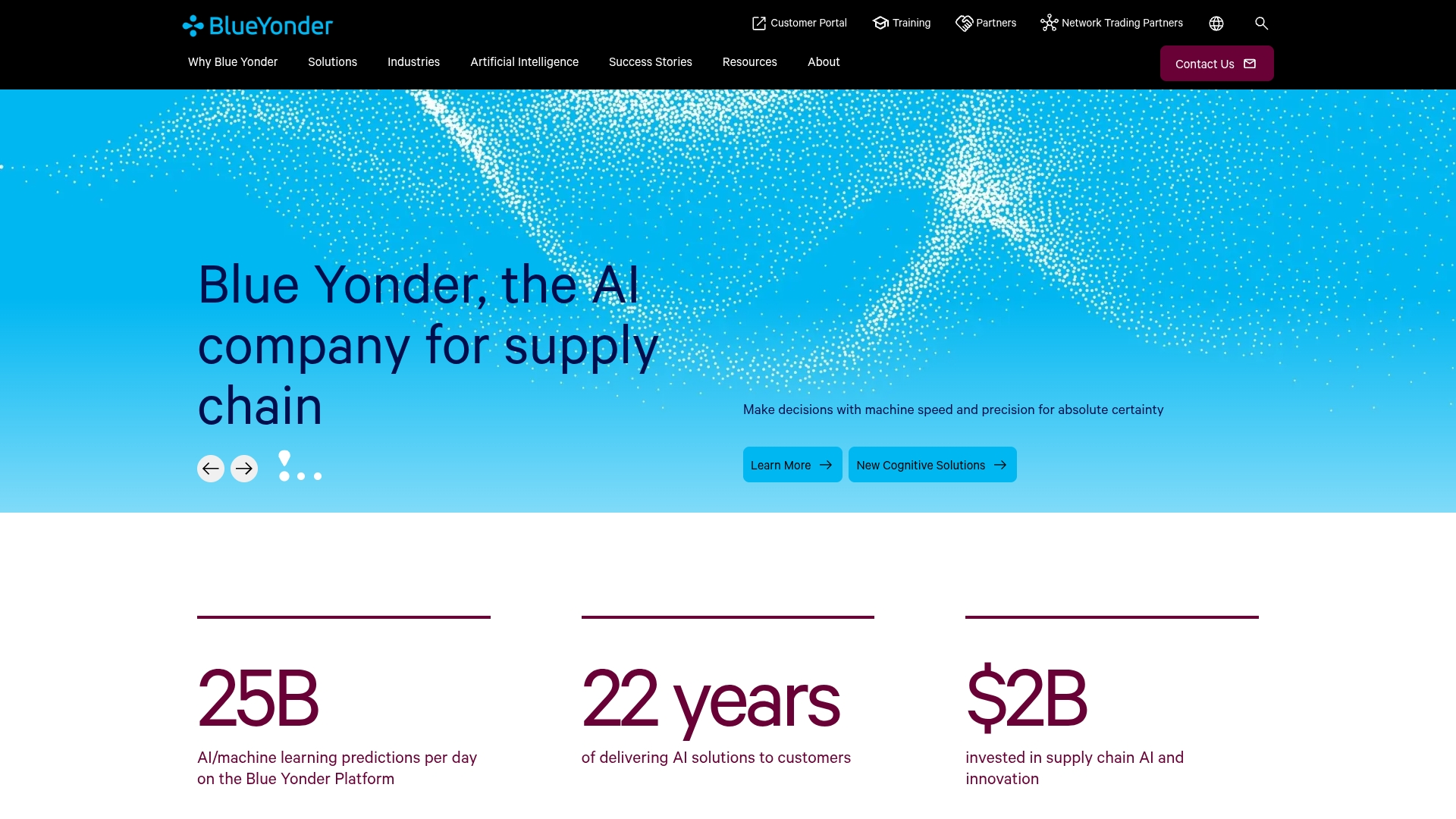
Use case: Blue Yonder’s Cognitive Demand Planning solution leverages AI and machine learning to analyze hundreds of internal and external demand signals, delivering up to 12% improvement in forecast accuracy for enterprise-level supply chains.
Key features:
- AI-driven forecasting that processes real-time market data, weather patterns, and promotional impacts to create unbiased demand projections.
- Collaborative planning environment that unifies sales, marketing, and operations teams around consensus forecasting.
- Advanced scenario planning capabilities that enable “what-if” simulations to assess risks and opportunities proactively.
Pricing:
- Contact Blue Yonder directly for custom enterprise pricing — the platform requires significant investment with licensing fees often reaching millions for demand planning modules alone.
Considerations:
- High total cost of ownership with complex implementations that can take months and require specialized consulting partners.
- Steep learning curve despite user-friendly interface, with some users reporting the need for extensive training and occasional manual intervention for complex scenarios like promotional planning.
5. Kinaxis
Kinaxis delivers real-time supply chain visibility and rapid scenario modelling for organizations navigating complex demand planning challenges. The platform specializes in concurrent planning technology, making it ideal for large enterprises that need to synchronize demand, supply, and inventory decisions instantly across their entire supply chain.
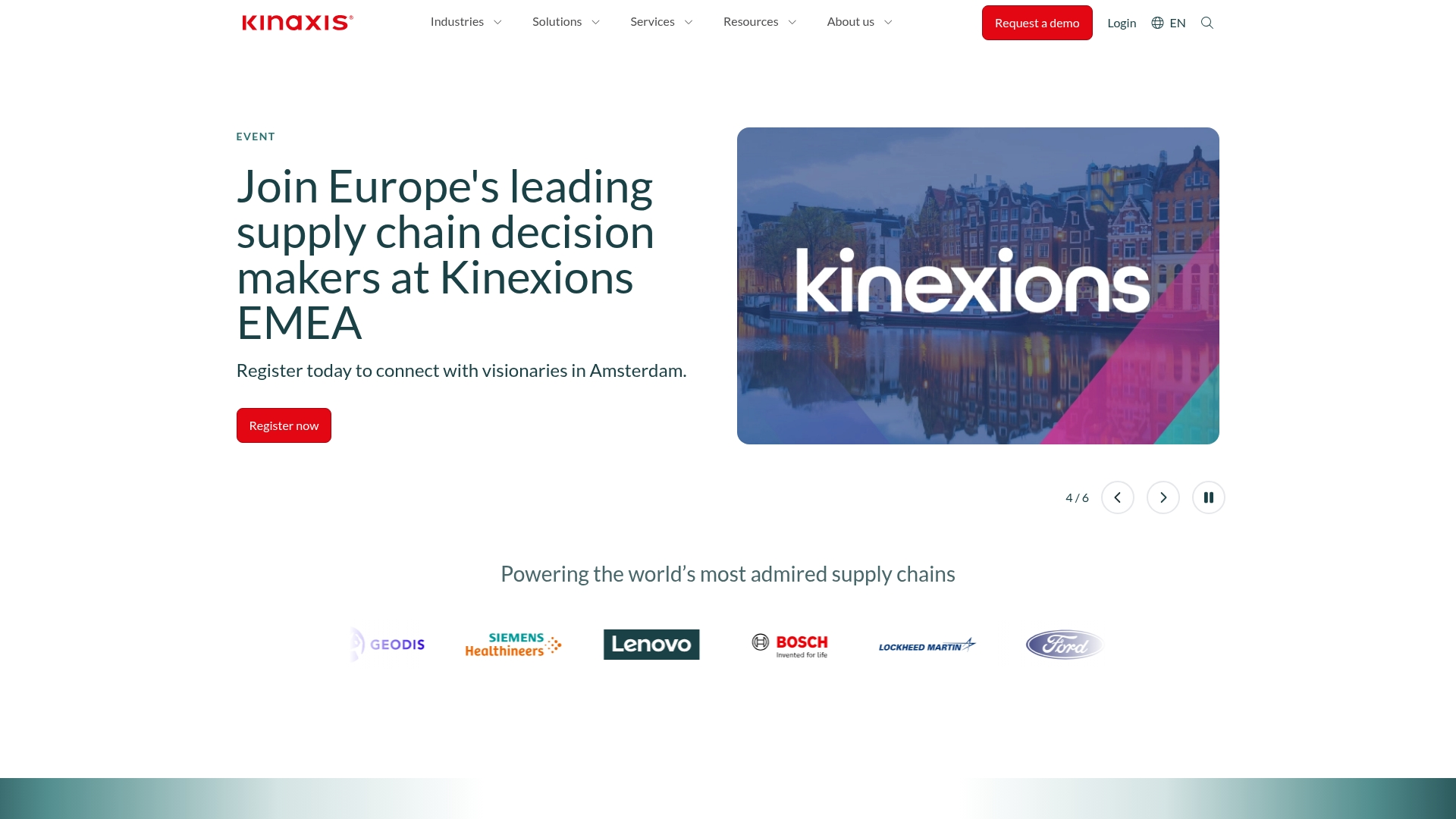
Use case: Kinaxis helps multinational corporations with complex supply chains create consensus-driven demand forecasts while enabling immediate synchronization across all planning functions.
Key features:
- AI-powered forecasting with Demand.AI that incorporates external signals like weather and social media trends for short-term demand sensing.
- Concurrent planning engine that instantly propagates demand plan changes across supply, capacity, and inventory planning.
- Unlimited scenario modeling capabilities for rapid “what-if” analysis to simulate market disruptions and promotional impacts.
Pricing:
- Pricing information not publicly available — contact Kinaxis directly for custom quotes.
Considerations:
- Performance can slow when handling very large and complex datasets, with some users experiencing delays during complex scenario analysis.
- Steep learning curve and complex training materials may require significant time investment to master the platform’s advanced capabilities.
6. SAP integrated business planning
SAP Integrated Business Planning delivers comprehensive demand forecasting and supply chain optimization for enterprise organizations. The platform specializes in deep ERP integration and real-time analytics powered by SAP HANA, making it ideal for large companies already invested in the SAP ecosystem.
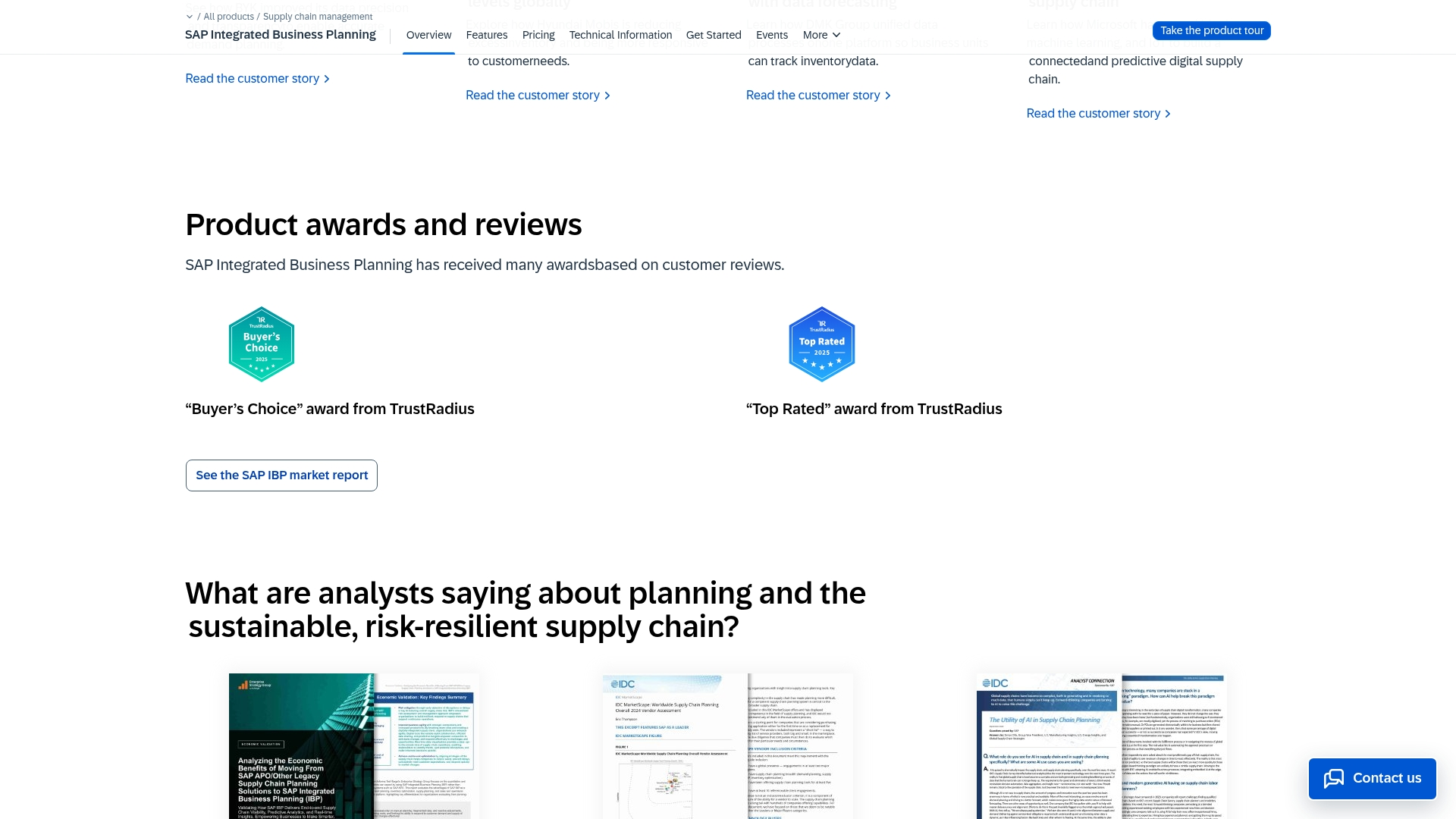
Use case: SAP IBP creates accurate, consensus-based demand forecasts through advanced statistical models, machine learning, and collaborative planning across sales, marketing, and supply chain teams.
Key features:
- Advanced forecasting algorithms with automatic model selection and AI-powered outlier detection for improved accuracy.
- Demand sensing capabilities that adjust forecasts in real time based on order patterns and point-of-sale data.
- Collaborative planning environment with Excel add-in and web-based interface for cross-departmental alignment.
Pricing:
- Pay-As-You-Go: $0.00 yearly (usage-based billing beyond free limits, 3-12 month contracts).
- Enterprise Agreement: $11,339.00 yearly (per Cloud Credit block, consumption-based model).
- Subscription: custom pricing (contact SAP for quotes, 3–60 month contracts).
- Free-trial: 90-day trial available with limited features for non-commercial use.
Considerations:
- Implementation complexity requires significant data governance and technical expertise to maintain effectively.
- Steep learning curve with potential for over-scoping projects that can overwhelm users and hinder adoption.
7. Oracle Demantra
Oracle Demantra delivers enterprise-grade demand planning with advanced statistical forecasting engines and AI-powered analytics. The platform specializes in complex, multi-dimensional demand modelling for large organizations with global supply chains, making it ideal for enterprises seeking sophisticated forecasting capabilities. While Oracle has transitioned focus to its cloud-based Fusion suite, Demantra remains a powerful legacy solution for established implementations.
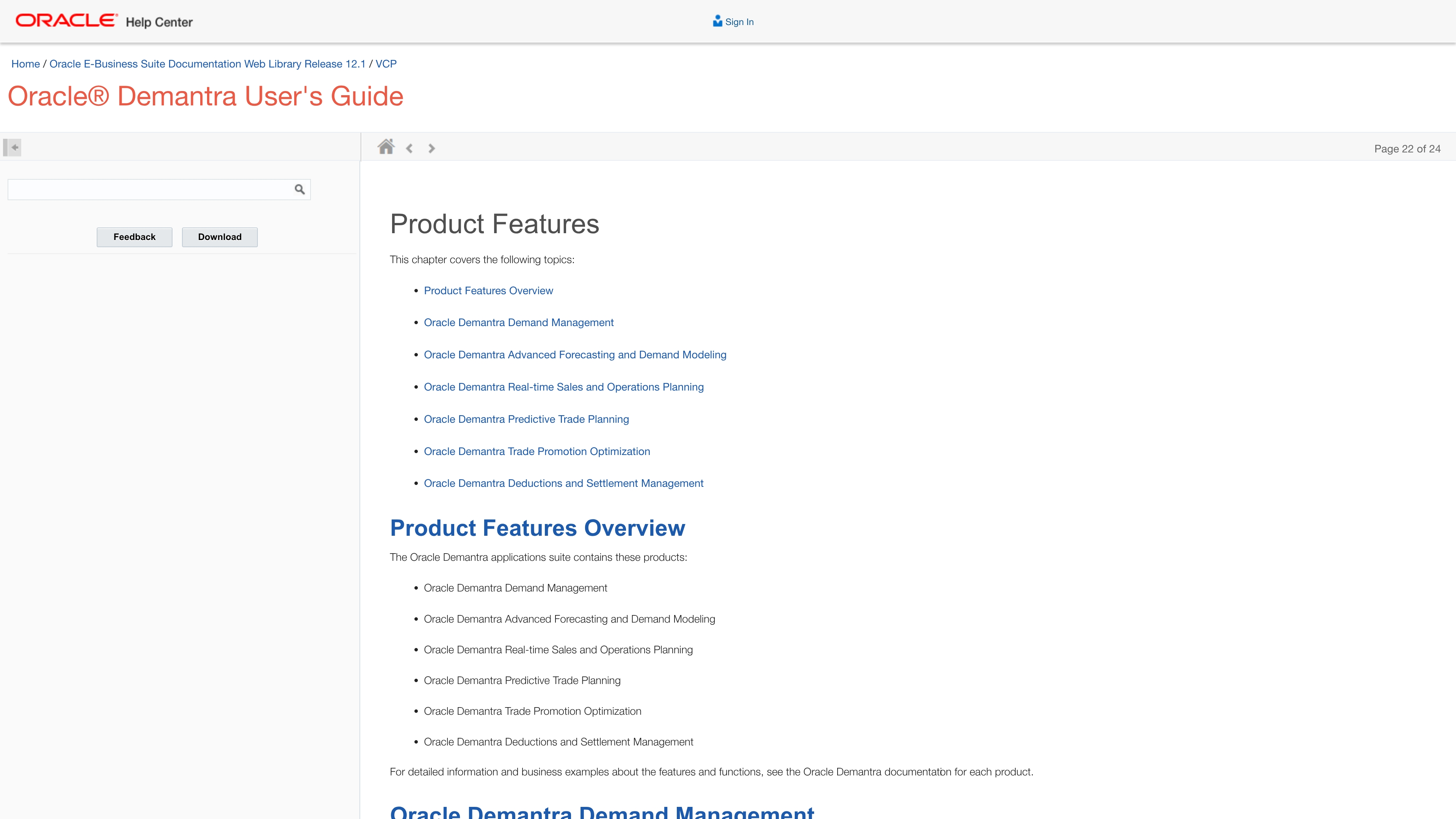
Use case: Oracle Demantra helps large enterprises create consensus forecasts by integrating inputs from sales, marketing, and supply chain teams through collaborative planning workflows.
Key features:
- Geneva Forecasting engine with Bayesian analytics and up to 20 causal factors for sophisticated demand modelling.
- Multi-dimensional data hierarchies supporting flexible planning across items, regions, and time periods.
- Collaborative workflow platform with exception handling and audit trails for forecast accountability.
Pricing:
- Pricing information is not publicly available and requires direct contact with Oracle sales representatives.
Considerations:
- Legacy on-premise solution with limited future development as Oracle focuses on cloud offerings.
- Complex implementation requiring significant training and technical expertise to maximize value.
8. IBM planning analytics
IBM Planning Analytics delivers enterprise-grade demand planning powered by advanced AI and the proven TM1 engine. The platform specializes in real-time scenario modeling and multidimensional analysis, making it ideal for large enterprises with complex supply chain requirements.
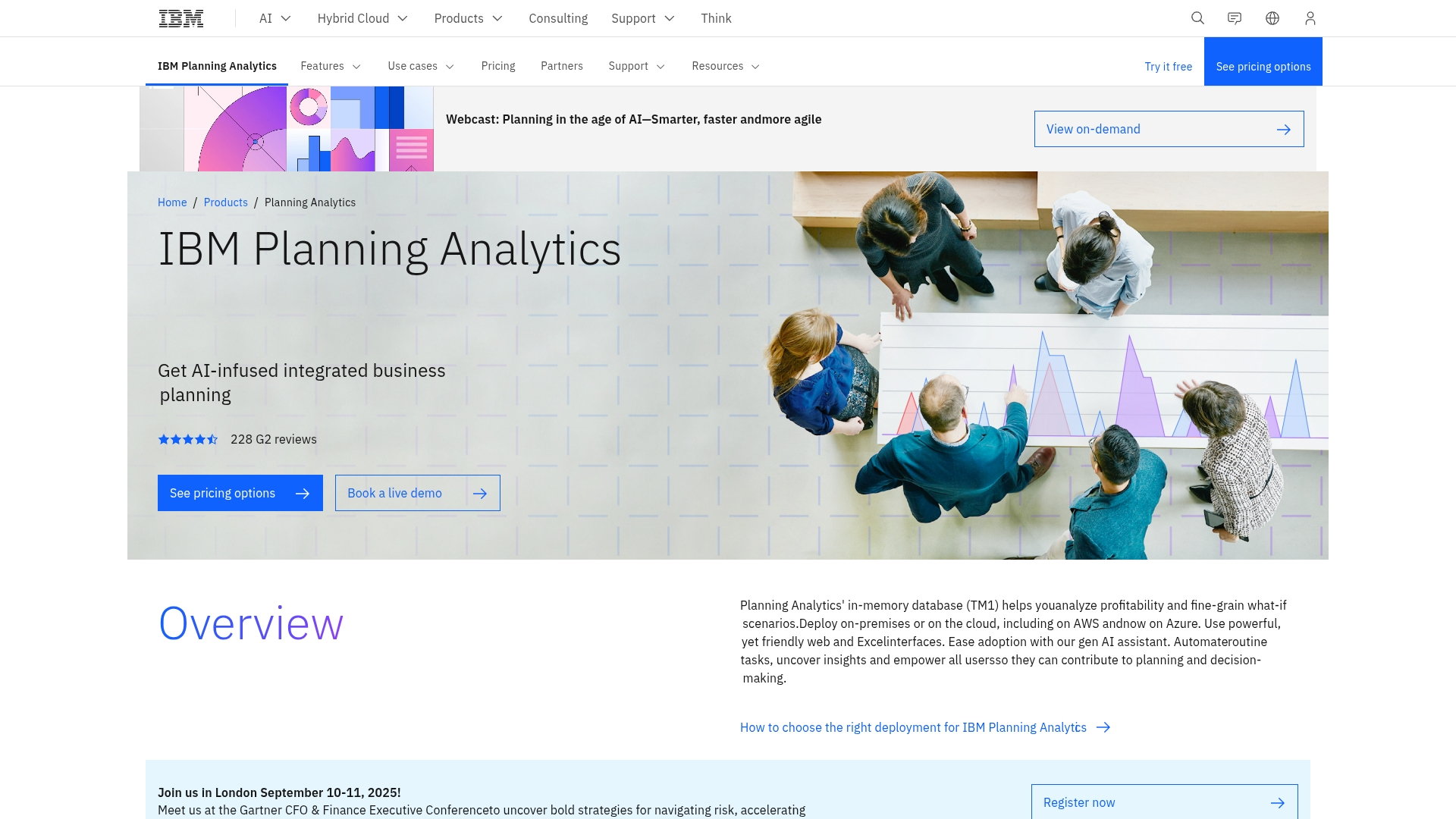
Use case: IBM Planning Analytics helps large enterprises optimize their supply chain operations through AI-infused demand forecasting and real-time collaborative planning across sales, marketing, and operations teams.
Key features:
- AI-powered statistical forecasting that analyzes trends, seasonality, and external data to improve demand prediction accuracy.
- Real-time “what-if” scenario modelling capabilities that enable instant impact analysis of market changes.
- Enterprise-wide collaboration platform that unifies teams across departments with end-to-end supply chain visibility.
Pricing:
- IBM doesn’t share public pricing details for Planning Analytics. Pricing is determined by your specific plan and needs, so it’s best to contact the IBM sales team for a personalized quote.
Considerations:
- Complex initial setup and maintenance may require specialized technical expertise and extensive user training.
- Higher price point can be a significant investment, particularly for organizations needing to scale capacity.
9. Forecast Pro
Forecast Pro delivers powerful statistical forecasting that transforms complex demand planning into a simple, automated process. The platform specializes in its “best pick” algorithm that automatically selects the most accurate forecasting method, making it ideal for organizations seeking sophisticated forecasting without the statistical expertise typically required.
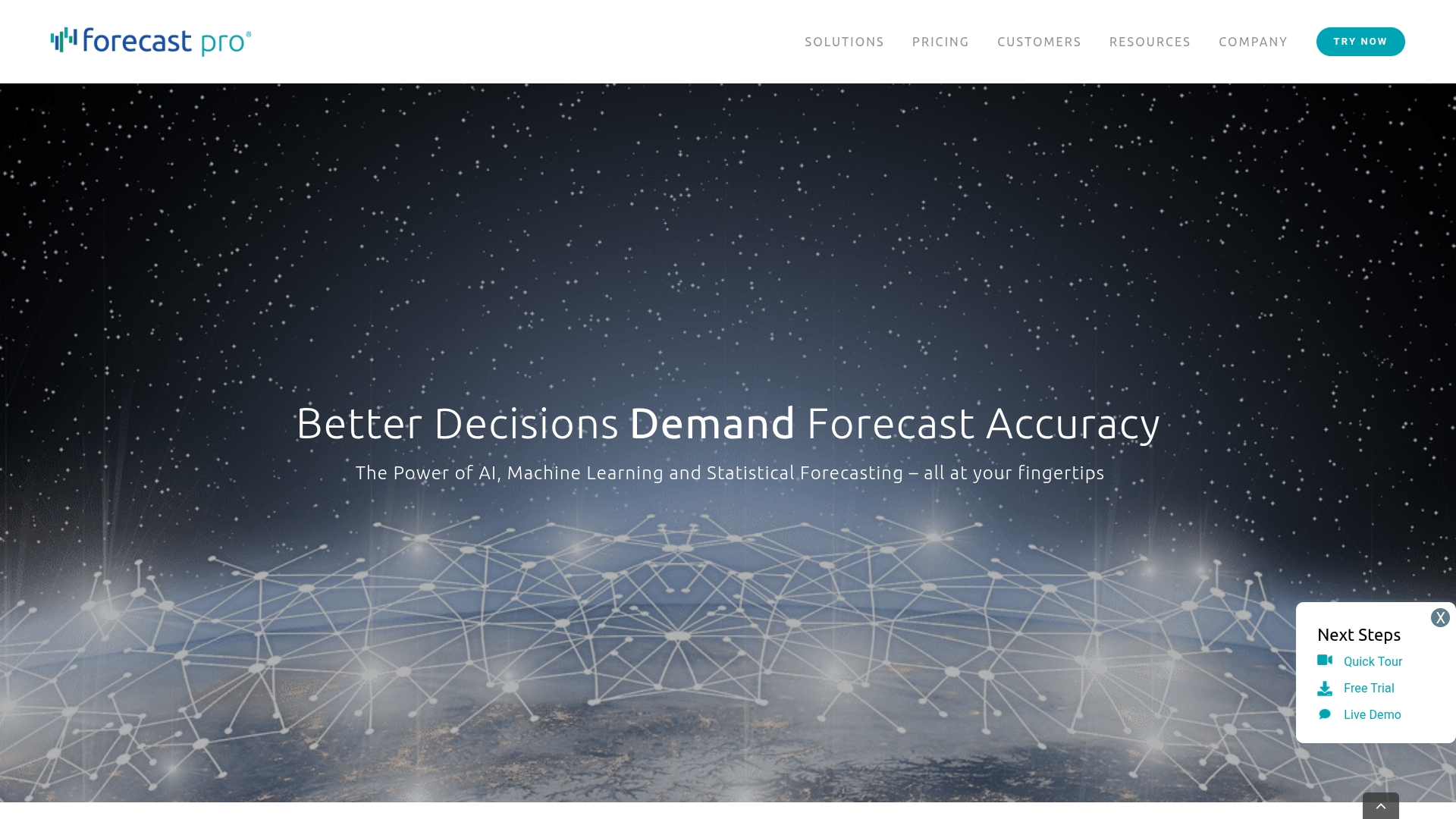
Use case: Forecast Pro enables businesses to generate accurate demand forecasts quickly using AI, machine learning, and statistical methods without requiring deep forecasting expertise.
Key features:
- Automatic “best pick” algorithm that selects the optimal forecasting method from exponential smoothing, Box-Jenkins, and machine learning models.
- Hierarchical forecasting with customizable hierarchies and multiple units of measure viewing.
- Excel-like collaboration grid for manual forecast adjustments with automatic reconciliation across all hierarchy levels.
Pricing:
- Forecast Pro 100: $1,995 per user annually.
- Forecast Pro Extended: $5,200 for 1 user; $3,650 per user for 2–5 users; $3,200 per user for 6+ users annually.
- Forecast Pro TRAC Forecaster: $7,875 for 1 user; $5,550 per user for 2–4 users; $5,000 per user for 5–7 users; $4,250 per user for 8+ users annually.
- Forecast Pro TRAC Collaborator: $1,950 for 1 user; $1,750 per user for 2–4 users; $1,350 per user for 5–7 users; $1,000 per user for 8+ users annually.
- Academic discounts available.
Considerations:
- Limited multivariate analysis capabilities, focusing primarily on time-series forecasting rather than multifactor regression modelling.
- Forecast accuracy depends heavily on the quality and availability of historical data, which can be challenging for new products or limited data scenarios.
10. Infor demand planning
Infor delivers industry-specific demand planning software that combines sophisticated forecasting methods with deep sector expertise. The platform specializes in probabilistic forecasting and pre-built industry templates, making it ideal for large enterprises seeking rapid deployment without extensive customization.
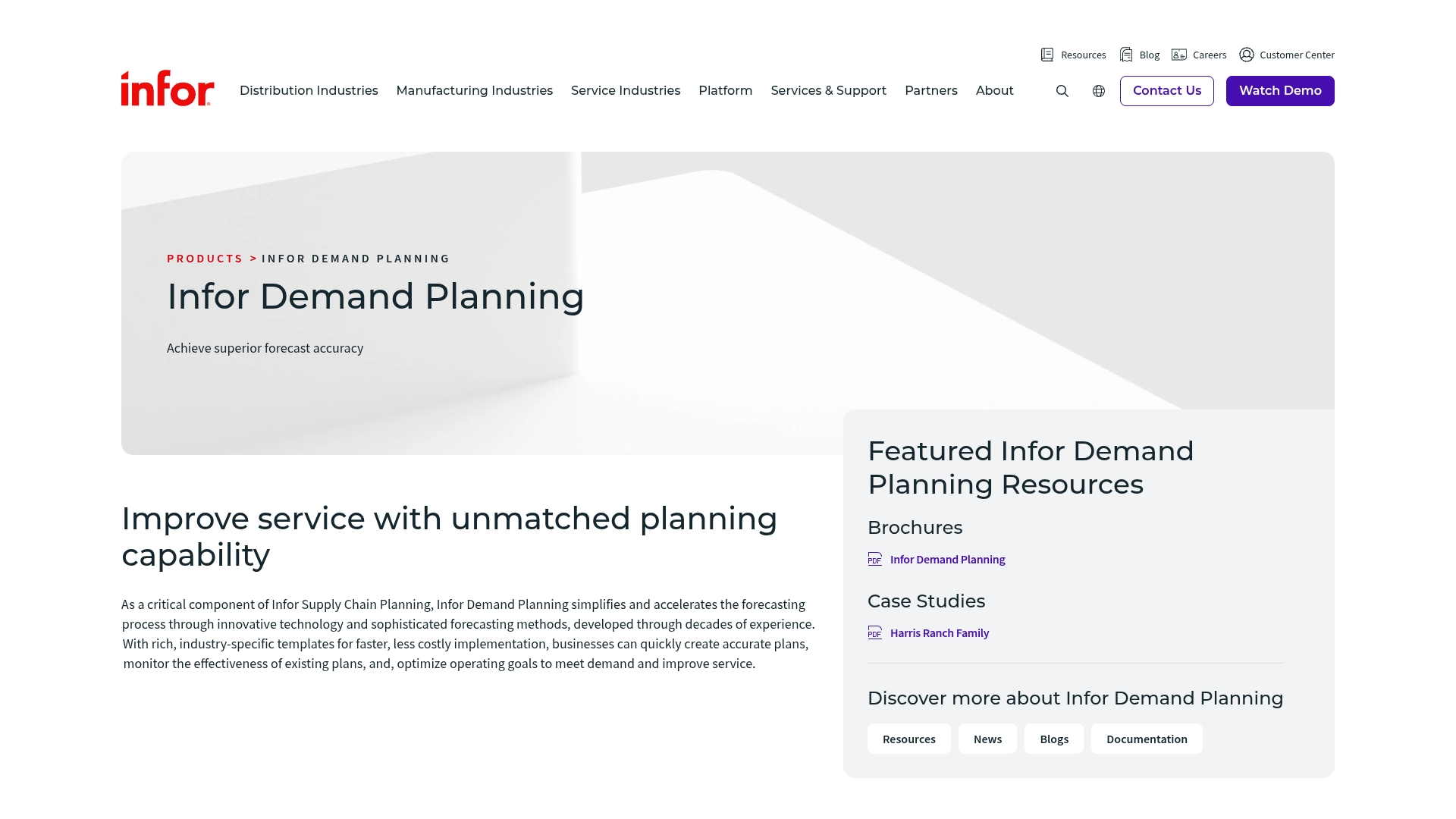
Use case: Infor Demand Planning helps enterprises generate accurate statistical forecasts while enabling cross-departmental collaboration through social platforms and real-time change tracking.
Key features:
- Probabilistic forecasting methods that automatically detect demand patterns and apply suitable analytical frameworks.
- Industry-specific templates for manufacturing, distribution, healthcare, and retail sectors to accelerate implementation.
- Social collaboration platform integration that eliminates silos and enables consensus-driven forecasting across teams.
Pricing:
- Subscription-based pricing model.
- Custom pricing available based on business needs and scale.
- Contact Infor directly for specific pricing details.
Considerations:
- Some users report a learning curve with advanced functionalities and occasional performance slowdowns with large datasets.
- Customer support responsiveness has been noted as an area for improvement in user reviews.
How AI enhances demand forecasting software
Artificial intelligence is redefining how sales teams plan and forecast, shifting from reactive adjustments to proactive, data-driven strategy. By uncovering trends and patterns that might otherwise go unnoticed, AI empowers organizations to predict demand with greater accuracy and confidence. Rather than replacing a sales representative’s intuition, it enhances it — turning instinct into insight.
This level of intelligence is most effective when built directly into the tools teams already use. A platform like monday CRM applies AI across the entire sales cycle, analyzing deal progression, communication trends, and pipeline movement to identify which opportunities are gaining momentum and which may need attention.
By embedding these insights into daily workflows, a platform like monday CRM keeps forecasts current, highlights potential risks early, and helps teams focus on the deals most likely to close. The result is a faster, more predictable sales process that gives both representatives and leaders the clarity to act with confidence.
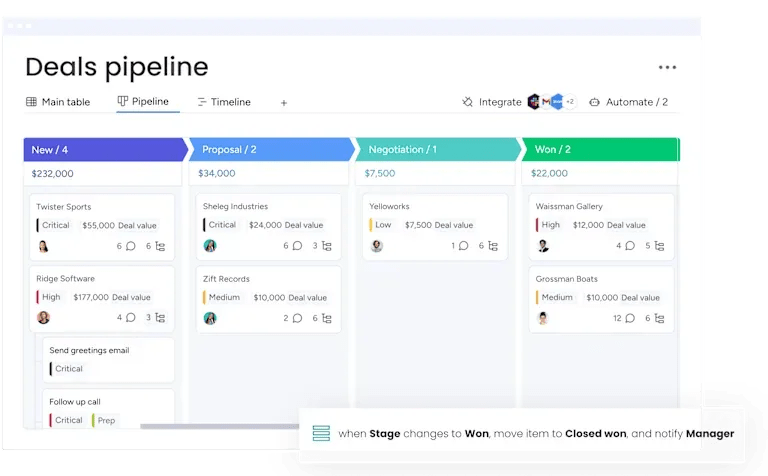
Maximizing value with integration and automation
True efficiency happens when your CRM and other business tools work together in sync. This connection frees your team from repetitive updates and gives them more time to focus on what matters most — building relationships and closing deals.
A platform like monday CRM creates a single, reliable source of truth for all customer information, ensuring every department has access to the same real-time data. That alignment turns scattered systems into a connected, collaborative workspace.
- Seamless data flow: lead and customer details move automatically between systems, keeping records accurate and consistent.
- Shared visibility: every team can access up-to-date deal and customer insights without switching between tools.
- Smooth collaboration: automated handoffs remove delays, helping sales, marketing, and operations stay aligned.
- Confident decisions: connected data eliminates guesswork, allowing teams to act faster and with greater clarity.
When your systems communicate effortlessly, integration and automation transform everyday operations into a unified engine for growth.
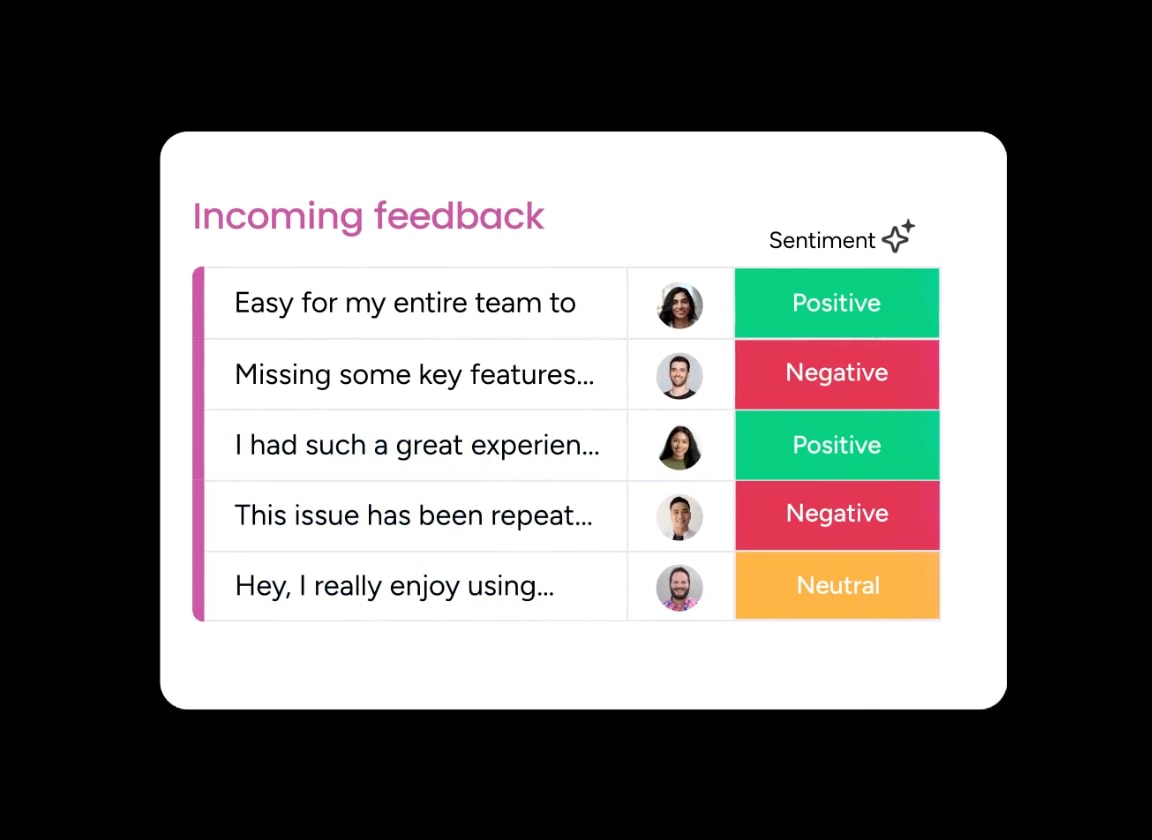
How to launch a demand planning solution that scales
A strong implementation is the first step toward achieving predictable revenue. It’s not just about setting up enterprise software — it’s about building a connected system that unites your entire team around accurate forecasts and clear priorities.
A platform like monday CRM simplifies this process by turning implementation into a fast, collaborative rollout rather than a drawn-out transition. Its intuitive setup lets you configure core forecasting and sales workflows quickly, giving your team immediate access to the tools they need to plan, track, and execute with confidence.
By approaching implementation strategically (focusing on quick wins and steady progress) your team experiences real value from day one. The result is a smooth path to adoption and a foundation that keeps everyone aligned, empowered, and ready to deliver consistent, predictable performance.
Transform your demand forecasting with monday CRM
When every part of your sales process — from forecasting to follow-up — operates in one connected system, your team gains the clarity to plan confidently and act decisively. Instead of reacting to market shifts, they can anticipate demand, allocate resources wisely, and close deals backed by real data.
monday CRM brings sales forecasting, pipeline visibility, and team collaboration together in a single, flexible platform. It turns scattered insights into a shared source of truth, giving your sales representatives the tools to focus on relationships, not reports. The result is faster decision-making, stronger alignment, and truly predictable revenue.
See how monday CRM can help your team forecast smarter, execute faster, and sell with confidence. Get started today and turn every forecast into growth.
The content in this article is provided for informational purposes only and, to the best of monday.com’s knowledge, the information provided in this article is accurate and up-to-date at the time of publication. That said, monday.com encourages readers to verify all information directly.
Frequently asked questions
What demand planning software works best for small businesses with limited budgets?
Small businesses can access powerful demand insights through comprehensive platforms like monday CRM, which integrates forecasting into a broader sales toolkit. This approach provides immediate value without the high cost or steep learning curve of a specialized, single-purpose tool.
How does demand planning software integrate with existing CRM systems?
Most modern demand planning tools integrate directly with your CRM, enabling a seamless flow of real-time customer and pipeline data. This connection ensures your forecasts are grounded in actual sales activity for significantly greater accuracy.
What makes demand forecasting software easy to implement quickly?
Rapid implementation is driven by intuitive, no-code interfaces, pre-built industry templates, and guided onboarding processes that require minimal IT support. Your team can start building forecasts and gaining valuable insights within days, not months.
How does AI-powered demand planning software handle seasonal demand fluctuations?
AI systems analyze historical data to automatically identify and account for seasonal trends, holidays, and other recurring patterns that impact demand. The platform continuously learns from new data, making your seasonal forecasts more precise over time.
What distinguishes demand planning software from supply planning platforms?
Demand planning focuses on forecasting what customers will want and when, while supply planning organizes the inventory and production required to meet that predicted demand. Understanding demand is the critical first step that informs all supply-side decisions.
Can demand planning software help sales teams close more deals?
Yes, by revealing market trends and customer buying cycles, it empowers sales teams to prioritize the right leads and time their outreach for maximum impact. When these insights are integrated directly into a CRM like monday.com, reps can align their efforts with real-time demand signals to close deals faster.
 Get started
Get started 


